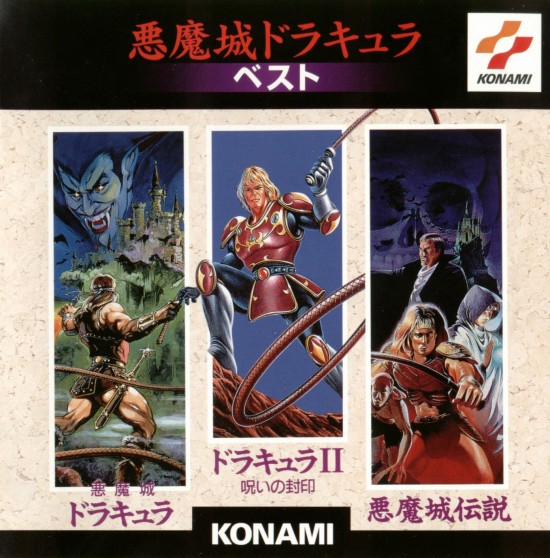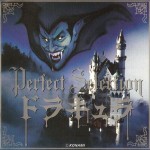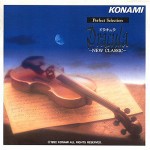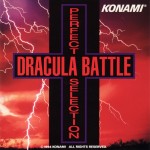Continuing in our “Castlevania Week” adventures, and simultaneously resurrecting our “Soundtrack of the Month” feature (something we haven’t run in a whole year!), today we bring you a special review for a very special album.
You can actually pick up multiple versions of the album. Its original CD print, one of Konami’s first albums with King Records, is catalog number KICA-1005, released in March 1990. Retro nerds might also be interested the cassette tape version released at the same time (KITA-1005). At the time, the album was named Akumajo Dracula Famicom Best. But when it was widely reprinted in 1998 (most people I know who have this album, have this reprint), they dropped “Famicom” from the album title (even though all the music is still from the Famicom). That album’s catalog number is KICA-7901, and wouldn’t you know it, CDJapan still has it in stock.
What this album contains, and what it doesn’t contain, is worth discussing at length. So, after the jump, I’ll give you the details.
The first thing I noticed when listening to this album was that, while all the music sounded familiar, the sound seemed different from what I remembered when playing the game as a child. Until I got to the last 3 tracks … those sounded perfect. Studying the album’s liner notes and reading about the album on the Internet, I figured out what was going on: while this is indeed the OST for the original NES trilogy, the version of audio we’re getting here is for the Japanese-only FDS (Famicom Disk System) trilogy. Apparently, the audio took on a new and different form for the cartridge-based Famicom, which we Americans would refer to as the NES proper. Those last 3 tracks on the albums are specifically NES versions of the music, all tracks from Castlevania II: Simon’s Quest (in Japan, the game was called Dracula II: The Seal of the Curse). Sadly, I know of no place where one can find the NES version audio on an official soundtrack for the Castlevania or Castlevania III: Dracula’s Curse. If any readers know otherwise and would like to correct me, that’s what the comments section is for!
So, let’s take a look at the tracklist, and then cover the audio in reverse order.
Arrange Version
01 – Distant Triumphant Return (Beginning) -From Akumajo Densetsu-
02 – Bloody Tears -From Dracula II-
Original Game Sound
Akumajo Densetsu
03 – New Determination
04 – Battle with the Will to Die
05 – Ralph’s Crisis!
06 – Darkness and Tension
07 – Escape from Underground
08 – The Last Battle
09 – Ending
Dracula II
10 – Message of Darkness (Naming BGM)
11 – Within These Castle Walls (Castle BGM)
12 – Bloody Tears (Roads by Day BGM)
13 – The Silence of the Daylight (Town by Day BGM)
14 – Dwelling of Doom (Mansion BGM)
15 – Monster Dance (By Night BGM)
16 – Last Boss (Last Boss BGM)
17 – Game Over (Game Over)
18 – A Requiem (Ending)
Akumajo Dracula
19 – Underground (Naming BGM)
20 – Prologue (Start BGM)
21 – Vampire Killer (Sneaking into the Castle BGM)
22 – Stalker (Tower BGM)
23 – Wicked Child (Outdoors BGM)
24 – Walking on the Edge (Underground BGM)
25 – Heart of Fire (Dracula Castle Main Building BGM)
26 – Out of Time (Clock Tower BGM)
27 – Nothing to Lose (Last Stage BGM)
28 – Poison Mind (Boss BGM)
29 – Black Night (Last Boss BGM)
30 – Voyager (Ending)
NES Version
31 – The Silence of the Daylight (Town Stage BGM)
32 – Bloody Tears (Street -day time- Stage BGM)
33 – A Requiem (Ending BGM)
Alright, so as I said above, those NES Version tracks are awesome. They instantly bring back what I loved about those early Konami games. “Bloody Tears” is, without question, my favorite of the tracks. It’s so catchy, it almost hurts. Everyone knows and loves this song. “Requiem” and “Silence of the Daylight” are also quite good, but they can’t touch the almighty power of “Bloody Tears.”
Now, tracks 19 through 30 are for the game that started it all, Akumajo Dracula (“Demon Castle Dracula,” or simply Castlevania). Composed by the duo listed in the game’s end credits as “James Banana” (part of a series of horror-movie-related puns), we now know the music comes from Kinuyo Yamashita and Satoe Terashima. After some short prologue music, we get right into it with the landmark track “Vampire Killer,” which is the second-most catchy song on the album (a close second to “Bloody Tears,” in my opinion). After that we have “Stalker” (originally misprinted as “Starker” in the 1990 release), the stage 2 BGM. This is an oft-overlooked track from the original game, but it has some great percussion and melodic hooks. Even better, though, is “Wicked Child,” my favorite among Yamashita’s compositions. The song follows a simple chord progression, but it has a wildly catchy melodic portion to it. I love the arpeggiated melody in the B section, followed by the rising harmonic thirds. So catchy, so perfect, so … so very Castlevania!
The next two stage themes aren’t quite as memorable, but they serve an important function for the game itself. “Walking on the Edge” is dark, chromatic, and intense. The audio track here also includes many of the game’s sound effects; perhaps the sound designers thought that since this song had the least going for it melodically, it would be a good place to insert the memorable sound effects. “Heart of Fire” marks the moment where you’ve finally gotten past all of the “outer” portions of Dracula’s domain and finally entered the castle proper. It’s technically the longest track among the first game’s OST, clocking in at 2:12 (six seconds longer than “Wicked Child”). It shares another feature with that song, in that it has those Baroque style 16th-note runs.
Then we hit “Out of Time,” the very first song celebrated the dreaded Clock Tower, almost always the hardest stage in any Castlevania game. This song has a fast tempo and really captures that perfect “Konami sound.” I absolutely adore this song.
The final bits of music — last stage, two boss themes, and the end credits music, are all great in their own right. However, I suspect that it is less memorable for many gamers, as it’s certainly difficult to reach this point in the game. But now, let’s move on to the black sheep of the trilogy.
Castlevania II: Simon’s Quest is much-loathed for a whole bunch of totally valid reasons. But its soundtrack is not one of those reasons. We’ve already discussed “Bloody Tears” (so awesome it hurts) and “Silence of the Daylight” (also quite good). But the less-celebrated track “Dwelling of Doom” also deserves some attention. And, of course, I think everyone knows “Monster Dance.” I would’ve liked to see this one get its NES Version placed on the disc as well (there was room for it, the full disc is only 64 minutes … but then, they also had a cassette tape constraint back in 1990). Still, it’s a fun and dance-able piece of music.
Then, we have Castlevania III: Dracula’s Curse. In Japan the game was entitled Akumajo Densetsu (Demon Castle Legend). Don’t let the short tracklist fool you. This is, without a doubt, the main course of the OST, and the track lengths are quite long. Instead of 1 minute and 2 minute songs, we have songs that are 6, even 7 minutes in length. Why? Because Konami decided each track should be a medley of songs from the game. For the full breakdown of what each track contains, I recommend reading the notes at vgmdb.
There’s a lot to love about Castlevania III‘s soundtrack, but for me, it can all be summed up by “Escape from Underground.” This track contains “Aquarius” and “Pressure,” both of which are songs for the Sunken City portion of the game, which is one of my favorite parts of the game. This music is fun and fast-paced.
Of course, there’s also “Beginning” (found in the track “New Determination”), which as much a fan favorite as a Konami favorite … they’ve used it in many games since CV3, almost as much as Vampire Killer and Bloody Tears have been re-used.
Now, the album’s opening has two arranged tracks. Track 2 is a different version of “Bloody Tears,” but it’s not an arrangement for arrangement’s sake. It was actually used in the arcade version of the first Castlevania. So even the first game has remakes of music from the second game … okay, that’s confusing.
Then we have this dance-rock version of “Beginning” as the opening arrangement. It’s pretty cool, but the mixing and production value is a little weak. It sounds needlessly echo-y and reverb-heavy, and the solo guitar work is mixed with a surprisingly low volume.
SO, that’s it. That’s the whole album. If you like the Castlevania series enough to have even one album in your VGM collection, but you don’t have this one yet, I’d have to ask you what is wrong with you. This is the good stuff. It’s the original. And it’s one I go back to fairly often. Pick it up before it actually does become hard-to-find… though if that happens, I wouldn’t be surprised to see Konami reprint it yet again. It’s just that good.
Tags: Akumajo Dracula, Akumajo Dracula Best, Castlevania, Castlevania Week, Famicom, Famicom Disk System, James Banana, King Records, Kinuyo Yamashita, Konami, Konami Kukeiha Club, NES, Review, Reviews, Satoe Terashima, SOTM, Soundtrack of the Month








































